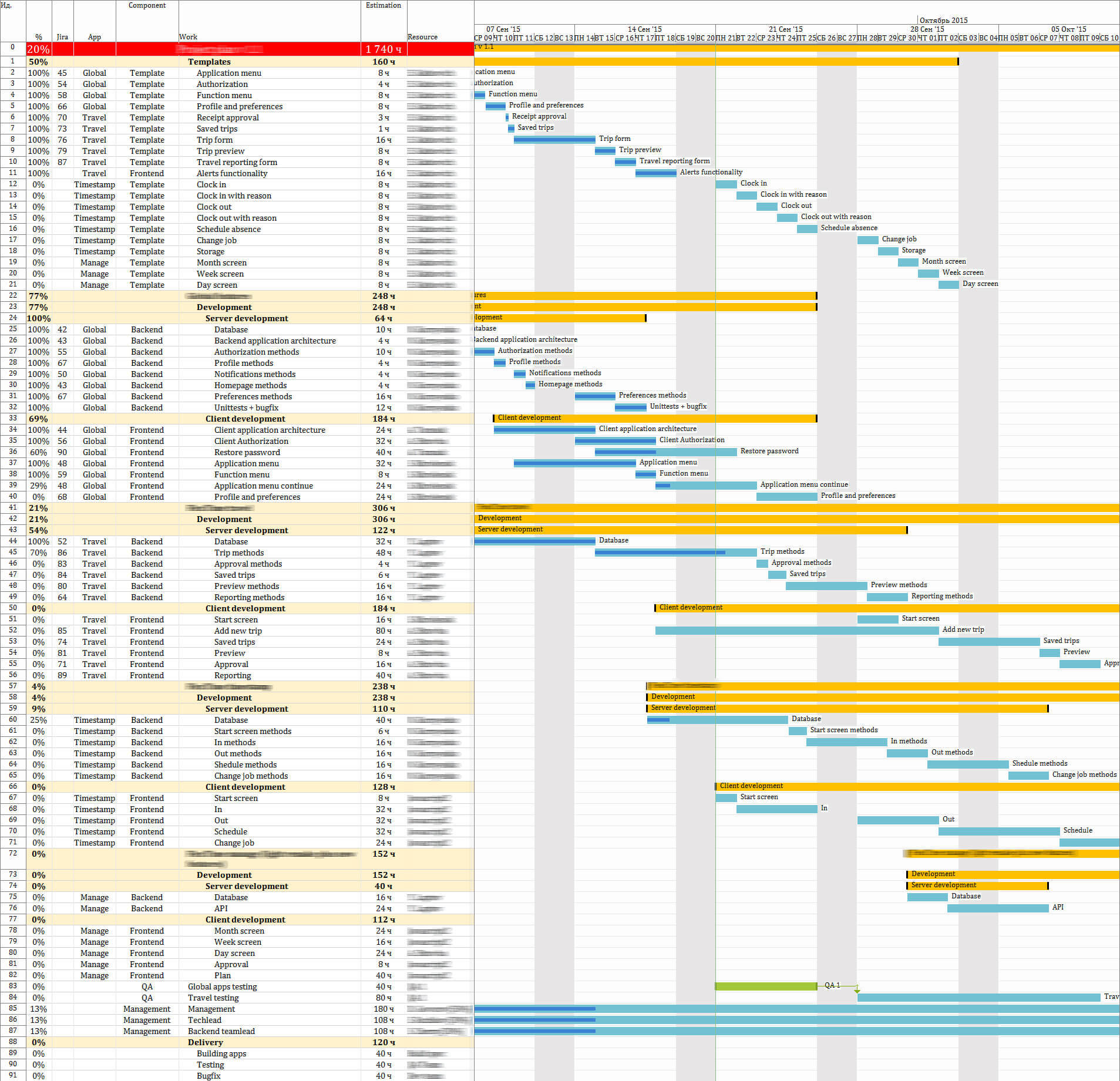Daily meetings as active planning

Previously considered daily meetings only for scrum projects. But after playing a couple of times in the sky, I came to the conclusion that using a short daily meeting is an integral part of team communications.
Without meetings, I learn about the problems much later and, accordingly, later I react, I have less time for reaction.
In this article I want to analyze the positive effect of daily meetings and describe how I do it, what are the benefits. I will not be surprised if, after writing this article, they will try to convince me and bring down the disadvantages of this approach (in my case, this is one of the motivators for writing this article).
Actual project plan
You need to start with the first integral element of the project - the project plan, which some colleagues neglect or do not know how to use.

The main mistake that PM makes when working with the plan is the lack of adjustments. I’ve seen it many times, and it was like that myself - when the plan is not adjusted until the end of the project. And until the very end of the project, the whole team actively plows on the idea of catching up with a plan that has lagged behind for a month or even more.
The main mistake is that the plan - must be a tool leading in the dark and predicting the future. And for this, he must be regularly adjusted to changing realities.
The right plan tool
Most often, managers refuse to make regular changes to the plan for several reasons: Complexity, impossibility.
The impossibility is caused by the fact that the plan is not a tool, but more a picture of the Madonna, which was made once and put on display. This problem is caused by the lack of a tool / software that will allow you to work with the plan in the most flexible and convenient way. I saw a lot of managers who use the Google calendar as a plan, or some kind of wild ruble gantt charts developed in the back room, or worse yet a tracking system with its many statistics and metrics, such as burndown chart and the like.
The difficulty is caused by improper planning and inability to work with the software in which the plan is executed.
When working with the plan, I use the program already tested over the years - Microsoft Project (the image above is from it).
Be sure to plan adaptively, without setting rigid bindings and sequences due to the difficulty of keeping the plan up to date. When planning, I rely on tasks in automatic planning and with alignment by identifiers and without interruptions. This allows you to change the current task and automatically adjust all subsequent ones to the changes.
Now about the benefits of daily rallies or as I call this process - active planning.
The benefits of daily meetings
Previously, I received feedback from the team on the result of work on the task, or through personal verification at different times of the day or week. Practice has shown that this approach eats up more time and brings chaos to the daily routine. In addition to personal chaos, I later learn about the difficulties or postponement of tasks and accordingly less frequently make changes to the plan, which was the result of the mess and the plan's mismatch with the realities.
Engaging in daily meetings every day at the appointed time, I disconnect from everything, turn on Microsoft Project and actively change the plan according to the testimony of the team.
The dialogue with the team is based on a scrum basis - what I did over the past working day, what I will do today and what difficulties I have.
Each member of the team has enough from a couple of seconds to several minutes to give an answer. It is enough for me to ask a couple of clarifying questions and within a couple of minutes to get information on the task on which the person is working and make changes to the plan.
Having an actual plan every day gives me the following useful elements:
1) Every day it’s clear what to do next and this information is relevant
2) The plan shows what will happen next and how we fit into the deadlines and this information is relevant
In addition to the actual plan, daily meetings have a positive impact and on team communication and motivation, team spirit.
Team spirit
Team spirit is influenced by the feeling of being part of a team. Everyone speaks out in turn and in a single format, this allows you to feel yourself the same as others. The report is given everything regardless of rank - Signor developers, middle, junior, team leader, technical expert, architect. All who have a task in the plan report. This additionally brings a sense of responsibility to the team, which entails an increase in motivation.
Motivation
The benefit of motivation is that a person is primarily ashamed of the team for regular disruptions to the plan for which he reports every day and looks like a white crow. I began to notice that many tasks began to end in the evening on the last day, and not "before lunch" on the current day. This is very important, because for almost every task it scribbles an additional 4 hours when the developer did not finish by the end of the working day but chattered and decides to finish it by lunch the next day (after all, according to the old “ joke ”: “Today” - tomorrow.)
Communications
The benefit of communications is that the team receives the latest news and finds out about the problems before they occur. On a regular basis, after a daily rally, the guys in the team organize themselves and help each other for 10-30 minutes to solve problems and difficulties, which they never did without a direct request or appeal when the daily meetings were not used.
Stress resistance
In addition to information about problems, daily meetings facilitate the emotional component in discussing problems. When you discuss problems every day, it’s easier for you to admit them than when you do it once a week. Making it easier to expose one’s difficulties entails reducing stress from work and, again, increases the motivation to be lazy and still do it so that you don’t talk about your difficulties the next day.
Total
To summarize. What I get EVERY DAY by applying this approach:
1) The current project plan
2) The list of difficulties in the team
3) Increase motivation to finish work on time
4) Relieve and reduce stress in the team when discussing problems
5) More overloaded and predictable work schedule of the manager
After the application of the approach ceased to miss the deadlines due to poor planning and achieved earlier completion of tasks due to earlier activity and solving difficulties. Now we don’t get on time due to lack of resources. But you must admit, this is a completely different story.
P.S. I am actively conducting 4 projects and meetings are being held from 9:30 to 11:00. By investing this part of the day at meetings, it turns out to have everything after 11:00 to solve problems and other project activities without distractions on "when you finish what you did."
